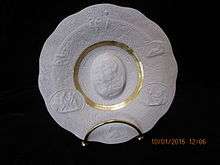Nanoconcrete
Nanoconcrete (also spelled nano concrete or nano-concrete) is a form of concrete that contains Portland cement particles that are no greater than 100 μm[1] and particles of silica no greater than 500 μm, which fill voids that would otherwise occur in normal concrete, thereby substantially increasing the material's strength.[2] It is a product of high-energy mixing (HEM) of cement, sand and water.


Role of nano particles
The incorporation of ultra-fine particles into a Portland-cement paste within a concrete mixture alters the concrete's material properties and performance by reducing the void space between the cement and aggregate in the cured concrete. This improves strength, durability, shrinkage and bonding to steel reinforcing bars.[2]
Manufacture
To ensure the mixing is thorough enough to create nanoconcrete, the mixer must apply a total mixing power to the mixture of 30–600 watts per kilogram of the mix. This mixing must continue long enough to yield a net specific energy expended upon the mix of at least 5000 joules per kilogram of the mix. and may be increased to 30–80 kJ per kilogram. A superplasticizer is then added to the activated mixture which can later be mixed with aggregates in a conventional concrete mixer. In the HEM process, the intense mixing of cement and water with sand provides dissipation and absorption of energy by the mixture and increases shear stresses on the surface of cement particles. As a result, the temperature of the mixture increases by 20–25 degrees Celsius. This intense mixing serves to deepen hydration process inside the cement particles. The nano-sized colloid Calcium Silicate Hydrate (C-S-H) formation increased several times compared with conventional mixing. Thus, the ordinary concrete transforms to nanoconcrete. The initial natural process of cement hydration with formation of colloidal globules about 5 nm in diameter[3] spreads into the entire volume of cement–water matrix as the energy expended upon the mix.[4] The liquid activated high-energy mixture can be used by itself for casting small architectural details and decorative items, or foamed (expanded) for lightweight concrete. HEM Nanoconcrete hardens in low and subzero temperature conditions because the liquid phase inside the nano-pores of C-S-H gel doesn't freeze at temperatures from −8 to −42 degrees Celsius.[5] The increased volume of gel reduces capillarity in solid and porous materials.
References
- Tiwari, AK; Chowdhury, Subrato (2013). "An over view of the application of nanotechnology in construction materials". Proceedings of the International Symposium on Engineering under Uncertainty: Safety Assessment and Management (ISEUSAM-2012). Cakrabartī, Subrata; Bhattacharya, Gautam. New Delhi: Springer India. p. 485. ISBN 978-8132207573. OCLC 831413888.
- M. M. Saravanan*, M. Sivaraja (2016-05-10). "STUDY AND DEVELOPMENT OF THE PROPERTIES OF NANO-CONCRETE". doi:10.5281/zenodo.51258. Cite journal requires
|journal=(help) - Raki, Laila; Beaudoin, James; Alizadeh, Rouhollah; Makar, Jon; Sato, Taijiro (2010). "Cement and Concrete Nanoscience and Nanotechnology". Materials. 3 (2): 918–42. Bibcode:2010Mate....3..918R. doi:10.3390/ma3020918. ISSN 1996-1944. PMC 5513515.
- Fridman, Vladen (March 1, 2018). "Nanoconcrete". Cite journal requires
|journal=(help) - R.A. Olson; et al. (1995). "Interpretation of the impedance spectroscopy of cement paste via computer modeling. Part III Microstructural analysis of frozen cement paste". Journal of Materials Science. 30: 5081.